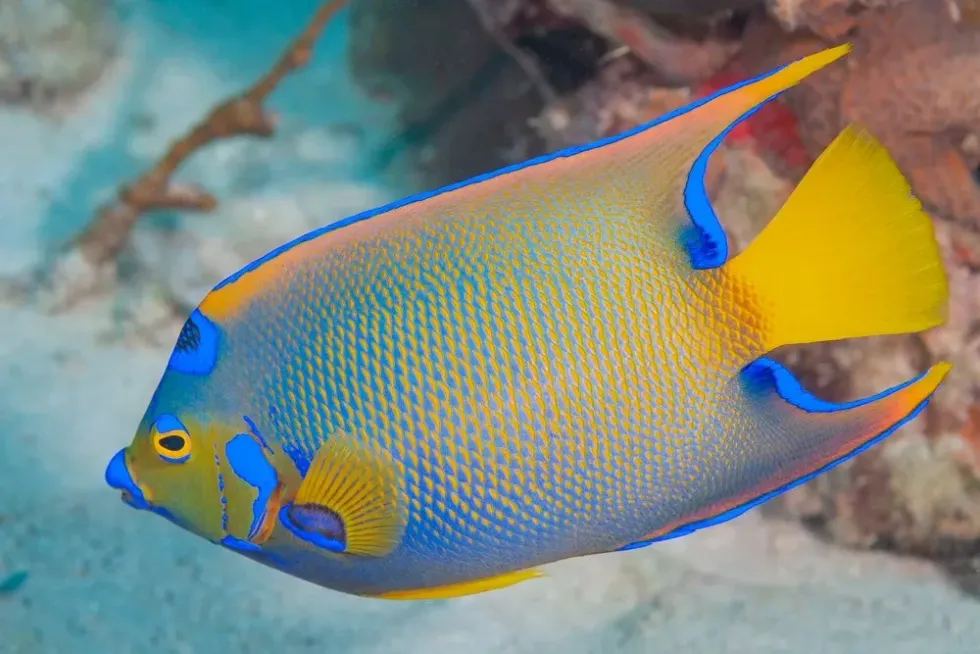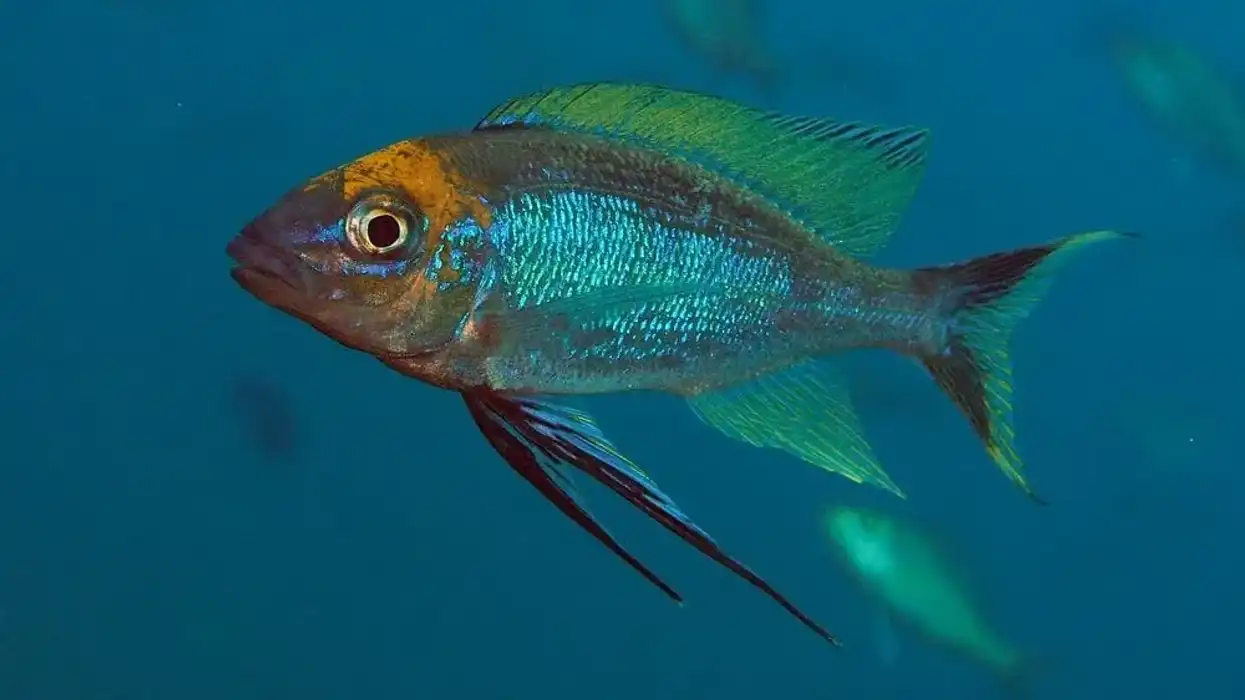Caution! What is that fish, going after shrimp of every size and attacking whatever comes in its way?
It is the Multicolour angelfish! These fish are usually found living in the reef, coral, and amongst frozen algae because of their shy nature.
The angel is not just an excellent swimmer but also an aggressive creature, constantly attempting to keep its reef safe from others.
However, in captivity, the angel becomes more aggressive than ever, and thus, it is usually advised that they be kept in a minimum of 70 gallons (265 l) of high-quality tank water, optimum temperature, and the ideal diet to keep them happy and hale.
Though they are not much in terms of size, they will still be seen actively hunting smaller prey for their diet and are very well known in their genus.
If you want to know more about fish from this genus, their size, and preferred temperature, or maybe about the large vs. small multicolor angelfish, then keep reading on!
You can also check out fish other than the angel and learn more about their diet, temperature, and other interesting details about the channel catfish and rainbow trout on Kidadl!
Multicolor Angelfish Interesting Facts
What type of animal is a multicolor angelfish?
Multicolor angelfish, Centropyge, is a type of fish.
What class of animal do a multicolor angelfish belong to?
Multicolor angelfish belong to the class Actinopterygii.
How many multicolor angelfishes are there in the world?
The estimated population of this semi-aggressive marine multicolor dwarf angelfish is unknown due to lack of research.
Where do a multicolor angelfish live?
Multicolor angelfish Centropyge species live in the Ocean. Marshall Islands, Palau, Cook Islands, Marianas, Fiji, Hawaiian Islands, and the Society Islands are places where these many-colored angelfish can be seen. They are usually seen in the water with low light.
What is a multicolor angelfish's habitat?
This Centropyge species is a deep-dwelling fish that can be spotted among rocks at a depth of 65.6-377.2 ft (20-115 m). Sometimes, these dwarf angels can be observed in shallower waters on reefs. The habitat of a multicolor angelfish is on the outermost reef slopes, where there are small amounts of rubble between places with robust coral development.
Who do multicolor angelfishes live with?
These marine fish have a social structure (temperament: semi-aggressive) that varies according to their environment.
In some regions, juveniles are seen in loose groups of four to 10, whereas in others, these species are observed singly, and in yet others, there'll be one male with three to five females. Although these are some of the more violent dwarf angelfish, they all still belong to the same family of multicolor angelfish.
As a result, the tank mates in a communal aquarium must not be smaller or less hostile fish than this one.
How long do a multicolor angelfish live?
The lifespan of angelfish Centropyge multicolor (which is spotted in Marshall island) is about six years with good attention and probably longer. Centropyge species have been reported to live in captivity for almost ten years.
How do they reproduce?
In Hawaii, these species of dwarf Angels are successfully bred and grown. These species are resilient, adapt well to confinement, and will frequently spawn in the aquarium if given the opportunity.
They do not seek unique spawning locations, such as coral outcrops, but instead dwell low in the good-reef, closer to the substratum.
Spawning begins with nuzzling, followed by a gradual ascent to a little under 3 in, where females discharge their eggs and sperm. The male does not pursue the female once they spawn, unlike many other dwarf angelfish.
What is their conservation status?
The Conservation status of multicolor angelfish and its tankmate yellow tang fish is declared as of Least Concern due to their stable population, by the IUCN Red List.
Multicolor angelfish Fun Facts
What do multicolor angelfishes look like?

*Please note, this is not a multicolored angelfish, but a Queen angelfish, a close relative of the multicolored angel.
The upper part of this deep water marine fish body is creamy white, with a yellow-orangish belly and a yellowish patch from face to chin. A deep blue mask-like pattern with vertical black stripes right above the eye and extending back to the place just above gills can be found on the head.
The color of the dorsal and anal fins is blue-black with deep blue borders, whereas the caudal fin is yellow. Pectoral and pelvic fins are also yellow - and they have a prominent Caudal fin.
How cute are they?
This deep-water fish found in Marshall island has many colors on its body. The dorsal and anal fins are bluish-black, and the caudal fin is yellow. With a magnificent color combination and an appealing description, this fish looks cute indeed! In fact, some have even given this genus the tag of an 'angel' fish because of their pretty description.
How do they communicate?
Information about the communication skills of semi-aggressive Saltwater angelfish multicolor is not studied well. However, they are constantly looking for live rock. This live rock forms one of their most prominent hiding places where they shelter against corals, spirulina algae, and clam mantles to protect themselves.
How big are multicolor angelfish?
The size of this deep water fish found on marshall Island is about three and a half in ( 8.89 cm). Altum angelfish's size is seven in (17.78 cm). Thus multicolor angels are smaller than Altum species.
How fast can a multicolor angelfish swim?
The marine angels found in Marshall Island are energetic, fast-swimming fish. They can easily swim from reef to corals to spirulina algae due to their size (which is just a few in) and can be seen zooming around locations like the Marshall Islands.
How much do multicolor angelfish weigh?
This semi-aggressive marine angel resides in the reef of marshall Island and weighs up to two lb (0.90 kg).
What are the male and female names of the species?
These dwarf angelfish (Centropyge multicolor) male and female species don't have any significant title.
What would you call a baby multicolor angelfish?
The babies of this pygmy angelfish, or dwarf angelfish, have no particular name.
What do they eat?
These species' main foods are benthic weeds, benthic algae, and zoobenthos, like tough coral polyps, mostly in the wild. Its preferred food is spirulina-enhanced flakes inside the aquarium and will occasionally eat pellets. Include algae eaters' frozen prepared diets and sponge as well as some brine shrimp and Mysis. They can eat a variety of commercially available foods.
They should feed regularly, initially with a variety of foods, such as brine shrimp and frozen Mysis. Then, in an aquarium, feed at least two times a day with a variety of natural food.
Including organically growing algae crops and sponges or other morsels in the aquarium can help them acclimate to prepared foods. Provide food three to four times a day if it is a small juvenile.
Are they dangerous?
Although these dwarf angels found in Marshall island water are a little aggressive, they are small in size, only a few in long, and no danger for Humans.
Would they make a good pet?
There are a lot of angelfish preparations that one can expect to undertake. They can be kept in both a fish-only and a reef-only tank.
It is considered a reef-safe species since it thrives in a corals-rich low light aquarium with sessile invertebrates. However, it will consume certain hard and soft corals species but generally will stay apart from the toxic soft corals. However, not all fish are harmful to corals.
In a good reef, pay attention to how it interacts with the corals. Except for peaceful species (like gobies, dartfish), they are good with clown triggerfish, dottybacks, larger angelfish, and damselfish in tanks.
With 70 gallons (265 l) in their water tank, they need plenty of live rock with multiple hiding places throughout since it spends most of its time swimming between hiding places. Putting an area of rubble for detritus to collect between and algae to grow on is a great plus.
It would also be an ideal candidate for a deep good-reef aquarium with selective corals.
But it may harm polyps of some stony and soft coral species, so housing it in reef-type aquariums needs to be done with care. Don't keep this fish with large species like lionfish, giant grouper, and soapfish.
These angelfish preparations mean that they can be kept with a moderate care level. Handle them with caution, though, just because their description is that of an angel, they are anything but!
Did you know...
The black phantom angelfish are among the rarest in the hobby. This fish is a unique species of angelfish from the northern Philippines.
As far as the tank size is large enough, two angelfish will be fine together, even though they're not a couple. Angelfish are generally calm since they can be aggressive when maintained in a smaller tank or whenever mating and protecting their eggs and offspring.
They are unlikely to kill or severely hurt each other (or even other fish) inside a communal aquarium due to their modest teeth.
The Tank size is determined by the number of fish you intend to keep. Maintain a maximum of four mature angelfish with the other tank mates in a 29 gal (109.7 l) communal aquarium. Begin with five to six young angelfish in a 55 gallon (208.1 l) aquarium.
Why is the multicolor angelfish also known as the pearl back angelfish?
Multicolor angelfish, also known as Many-colored angelfish or Pastel Pygmy angelfish, is a light orangish peach to yellowish-colored angelfish. The fleshy rocky and coral reefs (sessile invertebrates) and clam mantles may be nipped by the multicolor angelfish. Copper-based medications are toxic to it.
What's unique about the multicolor angelfish?
These small, vibrant colored fish found in the deep waters of Marshall Island have a medium caution care level. The mushy brittle and corals and clam mantles may be pinched by this multicolor angelfish. It is harmful to use copper-based medications for this marine species.
Here at Kidadl, we have carefully created lots of interesting family-friendly animal facts for everyone to discover! Learn more about some other fish from our rainbow cichlid facts and piranha facts pages.
You can even occupy yourself at home by coloring in one of our free printable Freshwater angelfish coloring pages.
*Please note, that the main image is not a multicolored angelfish, but a Queen angelfish, a close relative of the multicolored angel.









